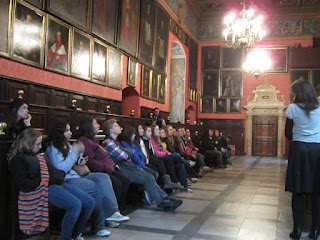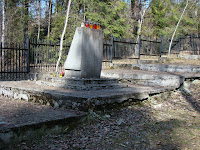
 Today we spent the day with our guide, Ewa, walking and learning the history of Krakow and the Wawel Castle district. Despite the drizzle and cold, we walked up the hill to Wawel.
Today we spent the day with our guide, Ewa, walking and learning the history of Krakow and the Wawel Castle district. Despite the drizzle and cold, we walked up the hill to Wawel.  Our first stop is the palace, where our guide shows us beautiful tapestries that were created in Belgium. She points out that the elaborate tapestries took one year to weave each square meter. The tapestries fill the walls of the ornate palace of the Polish nobility. During World War II, when the Nazis used this as their headquarters in Poland, the palace was the home of Hans Frank, the Governor-General of occupied Poland.
Our first stop is the palace, where our guide shows us beautiful tapestries that were created in Belgium. She points out that the elaborate tapestries took one year to weave each square meter. The tapestries fill the walls of the ornate palace of the Polish nobility. During World War II, when the Nazis used this as their headquarters in Poland, the palace was the home of Hans Frank, the Governor-General of occupied Poland. We enter the basement of Wawel Cathedral, and silently walk through the burial place of Polish kings and rulers. We visit downstairs, underneath the cathedral, and view the sarcophagus of Lech Kaczynski and his wife, who were killed in the plane crash in Russia in 2010 on their way to the first Polish-Russian commemoration to the atrocities of Katyn that took place during World War II.
We enter the basement of Wawel Cathedral, and silently walk through the burial place of Polish kings and rulers. We visit downstairs, underneath the cathedral, and view the sarcophagus of Lech Kaczynski and his wife, who were killed in the plane crash in Russia in 2010 on their way to the first Polish-Russian commemoration to the atrocities of Katyn that took place during World War II. From here, we walked down the hill toward Jagellonian University, the oldest university in Poland. We enter into a guided tour of this place, where students once included Copernicus and John Paul II.
From here, we walked down the hill toward Jagellonian University, the oldest university in Poland. We enter into a guided tour of this place, where students once included Copernicus and John Paul II. From here, we go back to the square, and enjoy an afternoon that includes lunch and shopping for souvenirs from beautiful, hospitable Krakow.
From here, we go back to the square, and enjoy an afternoon that includes lunch and shopping for souvenirs from beautiful, hospitable Krakow.Final Reflections - Holocaust Study Tour 2012
Gabi says:
I found myself on this trip. I see the true meaning of life, love and happiness. There is no way anyone can tolerate ignorance after this experience.
Allison says:
This trip was an extraordinary experience. It helped open my eyes and view certain situations from a different perspective. You must remain open minded to learn and accept new knowledge.
Devanni says:
This experience was a once-in-a-lifetime experience. I was able to learn more being in these countries than I could ever learn from reading books. With all the knowledge I have gained, I hope to educate others and share all this information.
Gabrielle says:
I learned on this trip that every action counts. The first action starts a chain reaction and what happens is determined by the next person. Now, I will always think my choices through.
Megan says:
This trip was a life changing experience. The Holocaust became so much more real for me and was brought to life in so many ways. I also gained so many new friends and learned so much more about who I am.
Hannah S. says:
This trip taught me so many thins about human beings. It has shown me that is does not take bad people to do awful things, rather it takes people not standing up for what they believe in to allow things like the Holocaust to happen. I can take this as a lesson to always stand up for what I believe in.
Kristina says:
This eye-opening experience has challenged me to comprehend the minds of the monsters involved in the years of planning the Holocaust. Systematic mass murder is an incomprehensible act that can only be taken into place by people who hold a skewed vision of authority. I have learned that it only takes one disturbed mastermind to create and uphold an army of puppets who target is to destroy mankind.
Amanda says:
Being on this trip for the last two weeks completely changed my view of humanity and how the human mind works. Mr. Barmore perfectly stated that there is no such thing as evil or crazy people; everyone has the ability to do these kinds of things. Once you realize the potential everyone has to do either good or bad, you realize how scary the world really is.
Sarah says:
This trip gave places meaning and gave nameless people faces. It made all my knowledge of the Holocaust come together and it gave me a better perspective of the horrors of the Holocaust. It really showed me the best and the worst of humanity.
Vanessa says:
This trip caused me to appreciate the talents and freedoms I have. Learning about the restrictions placed upon Jews during the Holocaust, in particular music which I am passionate about, really caused me to appreciate my talents and freedoms in this are much more.
Flori says:
This experience was very special to me. I learned so much not only about the Holocaust, but about myself. I learned that people have the same feelings, needs and wants regardless of their background.
Hannah C. says:
Like most teenagers, I have times in my life when I think I have it really bad. Going on this trip, however, gave me a new perspective on reality- my life is quite wonderful when you compare it to the dehumanization, destruction and isolation the Holocaust brought about.
Samantha says:
This experience has made me truly understand the importance of learning about these atrocities. All that I have learned in the past two weeks will be carried with me and spoken about for a very long time. I feel this is key since Holocaust survivors won't live forever and I will be able to pass their stories along to future generations.
Callie says:
Experience the HST has given new value to the relationships I have with my family. I have realized the importance of inheriting wisdom from our ancestors because without their knowledge we will make the same mistakes. I have also learned to love and appreciate my family regardless of circumstances because every moment counts.
Alyssa S. says:
Through this trip I learned to appreciate the bonds I have with family. In the camps people were forced to sever bonds of family which made me see the value of unity with each other. After this trip I will honor and value the time I spend with family and friends much more.
Tyler says:
This trip has affected me by helping me to show my emotions better. I used to hold my emotions in and not say anything to anyone about them, but I feel that I can open up more now about issues that matter.
Aidan says:
During my experience studying the Holocaust in Europe, I realized just how important it was for the Jewish people to keep faith in God. Although the Nazis dehumanized the Jews during the Holocaust, many Jews were able to keep their faith, regardless of the horrendous persecution they were facing. A person's faith makes each individual unique and cannot be taken away, no matter how awful one's situation may be.
Alyssa L. says:
The Holocaust Study Tour experience taught me about what the world can become if we live as bystanders. It is not always easy to stand up and say no, but if more people stand up for basic human rights, human beings might be able to survive with dignity and freedom; two things that victims of the Holocaust lost.
Ben says:
This Holocaust trip made me knowledgeable about how people who have authority in society can exclude others who may be "different". In reality people should be equal, but when those in power choose to degrade others, people act hurt and as in the Holocaust death camps emerged killings millions of innocent people.







 Th
Th






















































 As Alexandra Zapruder says in the introduction to Otto’s diary, “. . .the diary paints a picture of a group of people who exhibited a whole range of human conduct, including altruism and generosity, indifference and opportunism, impatience, selfishness, and cruelty, and whose conduct itself shifted and changed over time, defying all attempt at simplification or generalization.”
As Alexandra Zapruder says in the introduction to Otto’s diary, “. . .the diary paints a picture of a group of people who exhibited a whole range of human conduct, including altruism and generosity, indifference and opportunism, impatience, selfishness, and cruelty, and whose conduct itself shifted and changed over time, defying all attempt at simplification or generalization.”